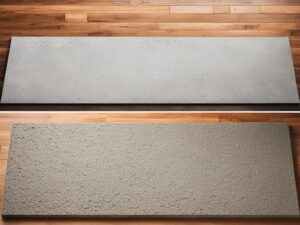Introduction
Hey there! Are you trying to pick the perfect paint color for your home and find yourself torn between Wickham Gray and Sea Salt? You’re not alone. These two colors are incredibly popular, but they bring very different vibes to a room. Let’s dive into the world of these two hues and figure out which one is right for you!
Understanding Wickham Gray
Wickham Gray is like that cool, crisp morning air – refreshing and invigorating. Originating from a palette that emphasizes natural and serene vibes, this color is a subtle gray with a hint of blue. It’s perfect for those looking to create a calm, yet sophisticated space. But beware, the lighting in your room can play tricks with this chameleon-like color!
Exploring Sea Salt
On the other hand, Sea Salt is like a gentle ocean breeze. It’s a blend of green and gray, creating a soft, soothing feel. This color is your go-to if you want to bring the tranquility of a seaside retreat into your home. It’s amazing how it changes its mood under different lighting conditions!
Comparing Wickham Gray and Sea Salt
Wickham Gray, a part of the Benjamin Moore paint collection, is a subtle gray with a noticeable hint of blue. This gives it a cool, serene quality that is often associated with modern and minimalist decor. Its ability to reflect light beautifully makes it an excellent choice for spaces where a fresh, airy feel is desired. Ideal for rooms like home offices or bathrooms, it provides a clean and crisp backdrop. However, in rooms with limited natural light, Wickham Gray can appear somewhat cooler and may need to be balanced with warmer tones in the decor.
Sea Salt, on the other hand, is a color by Sherwin-Williams and is known for its chameleon-like quality. It’s a blend of green and gray, with the unique ability to shift its appearance based on the lighting and surrounding elements. In a room with ample natural light, Sea Salt can appear more green, lending a soft, soothing, and somewhat organic feel to the space. In artificial light, it might lean more towards a muted gray. This color is particularly well-suited for bedrooms, living rooms, and bathrooms, where its calming presence can create a tranquil and relaxing atmosphere.
When comparing the two:
- Aesthetic Vibe: Wickham Gray offers a more formal, sophisticated look, while Sea Salt provides a casual, cozy, and organic feel.
- Color Behavior: Both colors interact uniquely with light. Wickham Gray tends to stay true to its cool gray tone, whereas Sea Salt can shift between green and gray hues.
- Room Suitability: Wickham Gray is ideal for creating a clean, modern look in spaces like kitchens and home offices, whereas Sea Salt is more suited for creating a relaxing environment in living rooms and bedrooms.
- Design Flexibility: Both colors are versatile but in different ways. Wickham Gray pairs well with bold and modern decor, while Sea Salt is a great choice for those looking for a softer, more earthy ambiance.
Pros and Cons of Wickham Gray
Wickham Gray shines in spaces that need a touch of elegance without overwhelming the senses. It’s great for offices or areas where focus is key. However, in rooms with limited natural light, it might come off as too stark or cold.
Pros and Cons of Sea Salt

Sea Salt is the epitome of versatility. It’s fantastic in bathrooms, kitchens, and living areas where a soft, welcoming feel is desired. But, in rooms with a lot of greenery outside, it might feel a bit too blended with the outdoor hues.
Wickham Gray in Real-Life Applications
Ever seen a room and thought, “Wow, that’s classy!”? Chances are, it might be sporting Wickham Gray. It’s a favorite among designers for creating a refined ambiance. But don’t just take our word for it; let’s look at some real-life examples.
Sea Salt in Real-Life Use
Sea Salt is like that friend who gets along with everyone. It’s been used in countless homes to create spaces that feel light and airy. Here’s how some homeowners and designers have successfully incorporated it.
Mixing and Matching with Other Colors
Pairing colors can be tricky, but not with these two. Wickham Gray loves to be matched with bold and bright accents, while Sea Salt pairs beautifully with soft, earthy tones. We’ve got some foolproof combos for you to try.
Tips for Choosing Between Wickham Gray and Sea Salt
Choosing paint isn’t just about the color; it’s about what it brings to your space. Consider the function of the room, your personal style, and how each color makes you feel. Here’s how to decide.
The Role of Paint Finishes
The finish can make or break your color choice. Wickham Gray in a matte finish can look stunningly contemporary, while Sea Salt in a satin finish brings out its cozy side. Let’s explore which finish works best for each color.
Maintenance and Longevity
Nobody likes a high-maintenance color. Thankfully, both Wickham Gray and Sea Salt are relatively easy to care for. But there are a few things you should know to keep them looking fresh for years.
Cost and Availability
Good news! Both colors are pretty affordable and widely available. But there are some price differences you might want to consider.
Customer Reviews and Feedback
Don’t just take my word for it. Let’s see what real users have to say about these colors. Spoiler alert: people love them, but for different reasons.
Conclusion
In the end, whether you choose Wickham Gray or Sea Salt depends on your personal taste and the atmosphere you want to create. Both colors offer unique benefits and can transform a space in their own ways.
FAQs
Wickham Gray is popular due to its versatility and subtle elegance. It’s a neutral color with a hint of blue, making it ideal for creating a serene and sophisticated ambiance in various settings, from living rooms to home offices.
Sea Salt, with its blend of green and gray, tends to create a warm, cozy, and inviting atmosphere. It’s reminiscent of a seaside retreat and is excellent for spaces where a calming and relaxing ambiance is desired.
Yes, you can use both colors in the same room, but it’s important to balance them well. They can complement each other, with one serving as the primary color and the other as an accent, to create a harmonious and visually appealing space.
For Wickham Gray, bright and bold accents like deep blues, vibrant greens, or even pops of yellow work well. Sea Salt pairs nicely with soft, earthy tones like sandy beiges, light browns, and muted greens.
Lighting plays a significant role in how these colors are perceived. Wickham Gray can appear more blue or more gray depending on the light, while Sea Salt can shift between green and gray tones. Natural light tends to bring out the truest colors, whereas artificial light can alter their appearance.



